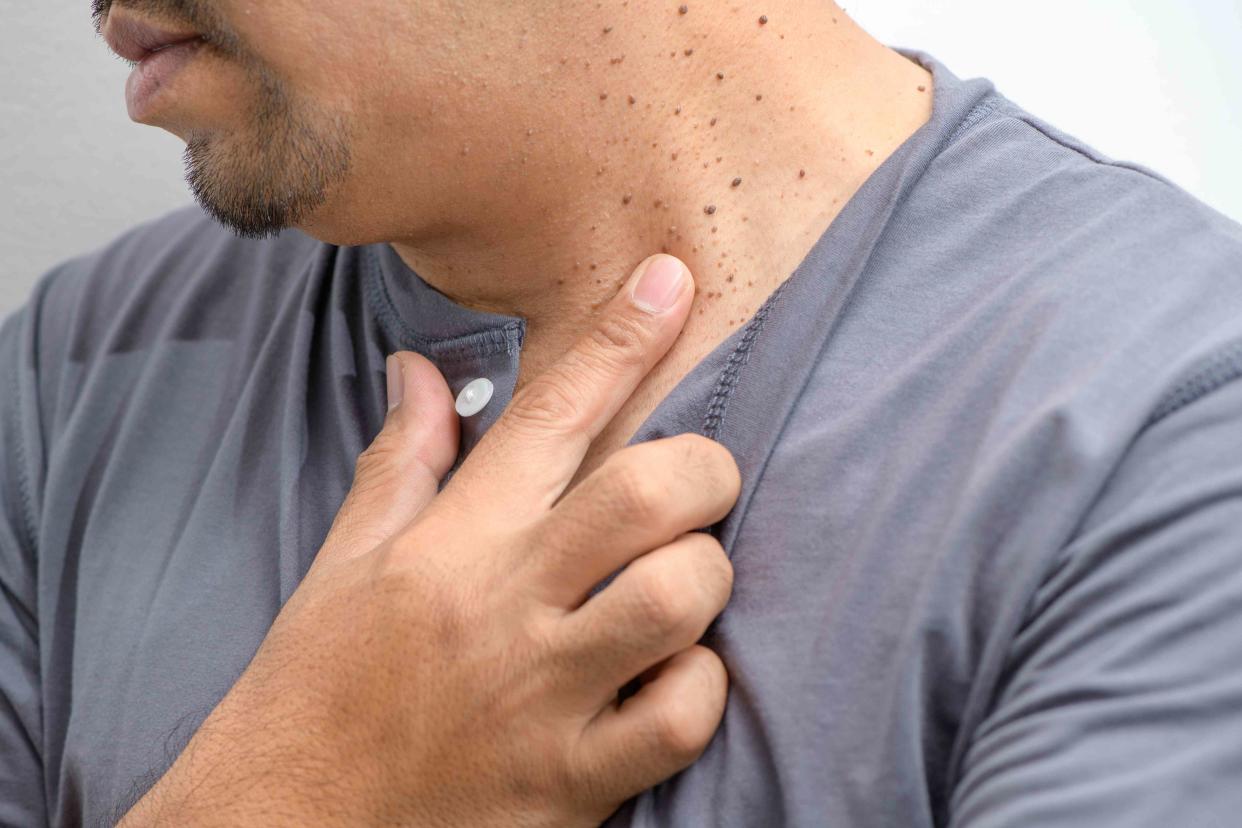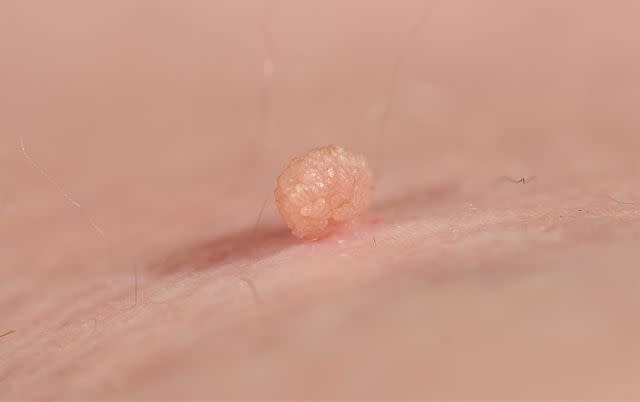What Are Skin Tags?

kwanchaichaiudom / Getty Images
Medically reviewed by William Truswell, MD
Skin tags are tiny, harmless growths usually found in folds of the skin like the armpits, neck, and eyelids. Experts think the growths develop due to friction from parts of the skin rubbing against each other.
It's estimated that at least half of the adult population will get a skin tag at some point in their lives, but people with certain health conditions and a family history of these skin growths are more likely to experience them.
Skin tags are also referred to as acrochordons. There's no specific treatment for them, but the growths can be removed if they're irritating or bothersome.
Skin Tag Symptoms
Skin tags look like a small mole hanging off the skin, sometimes by a tiny stalk. The growths are round and soft. Skin tags are typically somewhere between a few millimeters to roughly a centimeter in size. They can range in color by skin tone, from light tan to darker brown.

Tetiana Mandziuk / Getty Images
There might be just one skin tag present, or there may be multiple. As you get older, more can develop. The ones you have can also become larger over time.
Skin tags usually develop in certain parts of the body where the skin folds or touches. This includes areas like the:
Neck
Armpits
Eyelids
Groin or inner thighs
Under the breast
It is possible to experience some skin irritation at the site due to friction. This can happen when clothing, a seatbelt, jewelry, or another everyday item rubs against the skin tag. Larger skin tags in the armpit and groin might cause significant discomfort.
What Causes Skin Tags?
Frequent irritation to an area of skin, such as where two skin folds rub together, is believed to cause of skin tags.
Skin tags might also be a part of the normal aging process, with the growth developing due to the loss of the skin's elasticity.
Experts aren't exactly sure why skin tags grow on some people and not others, but it's estimated they affect roughly 60% of the adult population.
Risk Factors
It's believed several factors can dictate whether you are likelier to develop a skin tag. These factors include:
Age: Skin tags are seen more often on older adults. About a third of people in their 50s or 60s have a skin tag.
Genetics: People who have a family history of skin tags are more likely to experience them.
Diabetes: Research has shown a link between type 2 diabetes and skin tags.
Metabolic syndrome: This is a group of conditions that increase your risk of health issues like stroke and heart disease. You may have metabolic syndrome if you have at least three of the following: high blood pressure, high blood sugar, high triglycerides, large waistline, low good (LDL) cholesterol. Skin tags are more common among people with metabolic syndrome.
Obesity: Skin tags are more common among people with obesity.
Hormone levels: An imbalance in estrogen and progesterone may increase your risk of skin tags.
Anecdotally, there has been association between the human papillomavirus (HPV) and the development of skin tags. However, more research would need to be done to confirm any link.
How Are Skin Tags Diagnosed?
If you're noticing small growths on your skin you think may be skin tags, consider having them checked out by a healthcare provider.
Usually, a healthcare provider will be able to diagnose a skin tag simply by looking at the growth. They'll take into account its location and then look at the shape, size, and color. They might ask you if you've noticed any changes in these three factors
Treatments for Skin Tags
Because skin tags don't cause any harm, they don't necessarily need to be treated. But you may choose to have them removed if the skin tag becomes irritated, starts to bleed, or is painful. You may also want to have a skin tag removed if it develops near your eyelid and the growth impacts your eyesight. Some people may also want to have their skin tags removed for appearance purposes.
There are several different methods for skin tag removal, which will need to be performed in a medical office by a dermatologist (a physician who specializes in skin, hair, and nail conditions) or other healthcare provider. This provider may use:
Cryosurgery: Uses extreme cold to freeze off the skin tissue
Electrodesiccation: Involves an electric current via a tiny needle to destroy the skin tag
Laser therapy: Uses energy from a laser light device to precisely remove the skin tag
Surgical removal: The process of snipping off the skin tag at its base
After removal, skin tags usually do not grow back in the same spot. However, they can still form on other parts of the body.
Something that isn't recommended is for you to remove skin tags yourself at home. The U.S. Food and Drug Administration (FDA) warns that there are currently no approved prescription or over-the-counter medications for skin tag removal—and any products that may be marketed that way can cause skin damage, infection, or bleeding.
How To Prevent Skin Tags
Skin tags might not be preventable. One thing you can do in an attempt to prevent them is manage your weight since skin tags are more common among people with obesity. Since skin tags may be associated with diabetes, you can also try keeping your blood sugar levels at normal levels.
Some research has also shown that using syndet (synthetic detergent) bars when showering and moisturizing can prevent skin tags.
Related Conditions
Anyone can develop a skin tag. But researchers have found that certain medical conditions, such as type 2 diabetes, obesity, and metabolic syndrome are linked to the skin growths.
A genetic condition known as Birt-Hogg-Dubé syndrome may also be associated with skin tags. The syndrome is a rare skin disorder that causes people to develop lesions, particularly on their head, face, and upper torso. People with Birt-Hogg-Dubé syndrome may have many skin tags.
Skin tags don't put you at risk for any other condition, but having them and trying to remove them yourself can put you at risk for developing an infection.
Living With Skin Tags
Skin tags don't pose any health risks. However, they can get irritated with friction. One thing you can do to prevent that irritation is not wear jewelry around your neck so you avoid creating friction against the lesion. You can also avoid skin tag irritation by wearing loose-fitting, non-synthetic clothing. If your skin tag is big enough where it becomes painful or is in an area where you it physically or cosmetically makes you uncomfortable, talk with a healthcare provider about your removal options.
Frequently Asked Questions
Are skin tags a warning sign of another health condition?
There are also some links between skin tags and diabetes, but simply having one or more skin tags doesn't automatically mean you're at risk for the condition. Check with a healthcare provider if you're concerned about the development of skin tags and your overall health.
Can you cut off skin tags?
Experts do not recommend trying to remove a skin tag at home. That's because attempting a DIY removal could result in skin injuries, infection, or scarring. It could even delay a skin cancer diagnosis if the growth in question is not actually a skin tag. It's best to check with a healthcare provider if you're interested in removing a skin tag.
Does apple cider vinegar work to get rid of skin tags?
While there are anecdotal tales of using apple cider vinegar, tea tree oil, and other natural remedies to remove a skin tag, there is no scientific evidence backing these methods. The FDA actually warns against using any kind of at-home products marketed as being able to remove skin tags and says that just because something is labeled as "natural" doesn't necessarily mean it's harmless.
For more Health.com news, make sure to sign up for our newsletter!
Read the original article on Health.com.

